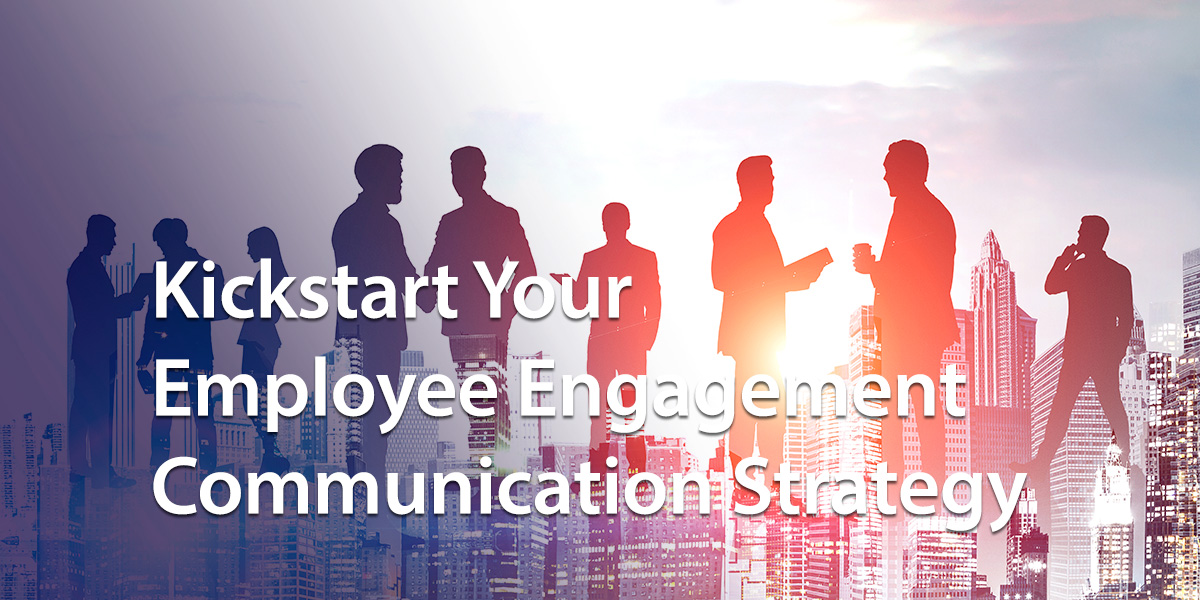Kickstart your employee engagement communication strategy with these best practices.
Whatever way you cut it, effective communication is the icing on the cake of employee engagement. Communication is a vital ingredient in developing the personal connections that create a positive work environment. Good communication keeps employees informed, ensures they feel valued, and ultimately drives organizational success.
However, according to the latest Gallup data, only 32 percent of US workers are actively engaged in the workplace. There’s a lot of work still to be done.
Today’s post will set you on the right track to improve employee engagement. And effective communication is the first base. We’ll explore the essential elements of effective communication and share tips on improving internal communication. We also discuss best practices for creating effective communication strategies.
Let’s get started.
Why Communication Is Essential For Employee Engagement
Internal communication isn’t just about relaying information – critical though that is. Improve internal communication, which will also foster employee engagement and create a positive company culture. Here’s how:
Connection And Trust
Regular communication builds bridges between employees, managers, and the leadership team. Two-way communication ensures workers feel heard and understood, and they develop trust and a sense of connection with the organization.
Clarity And Alignment
Clear communication ensures that employees understand their roles, goals, and expectations. There’s less room for misunderstanding. Team members are on the same page, syncing with the company vision and the organization’s goals.
Feedback Loop
Two-way communication channels create an employee feedback loop. And constructive feedback promotes growth and motivation and helps employees and the organization improve.
Inclusion And Belonging
Open and transparent communication creates an inclusive workplace. Employees feel valued and included and are more likely to give their best.
Recognition And Appreciation
Acknowledging workers’ contributions boosts morale and employee satisfaction. In data from the Incentive Research Foundation, 84 percent of respondents feel more motivated when they receive recognition. Communication tools that enable appreciation will lead to happy, engaged employees.
Cost of Poor Communication
Poor communication is bad for your bottom line. Some research estimates that it could cost as much as 18 percent of the total salaries paid. And that’s another compelling reason to prioritize effective communication.
Must-Haves For Effective Communication
Before launching into an internal communication strategy, it’s essential to understand the elements involved in good communication. Let’s go ahead and explore the must-haves to drive your internal comms strategy.
Honesty And Transparency
Whether communicating inside or outside work, speaking the truth is always the way to go. It builds trust and is the foundation of strong personal connections. Transparent communications ensure team members hear things from their managers first rather than the grapevine.
Clarity And Conciseness
Brevity is your best friend when it comes to internal communications. With information overload and workplace distractions at an all-time high, concise messaging ensures you cut through all the noise. Keep communications concise, and your words have more impact, helping team members absorb more information quickly.
Frequency
One root cause of poor communication is frequency. Often, we simply are not communicating enough. Use the full range of internal communication channels, from instant messaging to video conferences and in-person meetings, to check in regularly with team members.
Frequency is especially important to remote employees who may otherwise feel disconnected from the central office.
How To Create An Employee Communication Strategy
You’re ready now to get down to the business of creating your communication strategy. Follow these simple steps to ensure your internal communications hit the spot with engaged employees.
Review Your Current Communication Strategies
The first step is to review your current practices. What communication tools are you using, and which ones engage employees?
Your current approach will undoubtedly have strengths and weaknesses. The insights gained will ensure that your employee communication strategy builds on those pluses and eliminates the minuses.
Set Goals And Timeframes
The next step is to define what you want to achieve and identify SMART goals for the internal communications strategy. You may want to begin by focusing on the areas you need to improve. And remember to include some quick wins. A few early successes will give the internal communications strategy momentum from the get-go.
Here are a couple of sample SMART goals to kickstart your thinking:
Intranet Adoption Goal
- Specific: Boost intranet usage among frontline employees.
- Measurable: Increase intranet adoption by 20 percent within the next six months.
- Achievable: Promote intranet features through targeted campaigns on multiple communication channels.
- Relevant: Streamline communication and knowledge sharing.
- Time-bound: Achieve the goal by September 2024.
Strengthen Leadership Communication
- Specific: Enhance Leadership Communication Effectiveness
- Measurable: Conduct quarterly leadership town halls with active participation from the senior leaders.
- Achievable: Provide leadership training on effective communication.
- Relevant: Foster transparency and alignment.
- Time-bound: Implement the new approach by the end of Q1 2025.
Identify Your Success Measures
Your internal communications strategy can and should be measurable, just like every other aspect of your business. Choose some core metrics to track over time and demonstrate that the plan works.
Here are some possibilities to consider:
Open Rates And Read Receipts
Monitor open rates and read receipts for each communication method. High rates indicate effective communication. You may find that some channels hit the spot more than others.
Page Visits And Logins
Track the frequency of employees accessing the intranet or other internal communications platforms. Regular logins demonstrate that you have an informed and engaged workforce.
Employee Feedback
Harvest feedback from workers through employee surveys, focus groups, and two-way communication channels. Find out straight from the horse’s mouth what employees think of your communications and areas for improvement.
Regular surveys are also a valuable tool for tracking employee engagement. As the strategy rolls out, you should improve employee engagement levels across the board.
Employee Turnover Rates
Turnover rates speak volumes about the company culture, employee morale, and the employee experience. Happy, engaged workers are less likely to leave the organization, so keep a watchful eye on this critical metric.
Regularly Review Your Internal Communications Strategy
Your strategy shouldn’t be a set-and-forget task. If you are serious about improving employee engagement, be proactive and regularly review your internal communications. An engaged workforce doesn’t just happen. You need to continue working on it. New technologies and tools may require different communication skills and adjustments to the strategy.
Keep Internal Communication Going With These Best Practices
Now that we’ve discussed how to get started on your internal communication strategy, it’s time to explore how to keep employees engaged.
The following tools will maintain your company’s success and increase employee engagement:
One-On-One Meetings
These are the cornerstones of good communication. And they are one of the most effective tools to boost engagement. Employees and managers develop personal connections and build mutual trust in one-on-one meetings.
Team Meetings
Team meetings allow all employees to connect, share the same information, and drive a common understanding of goals and objectives.
However, don’t forget your remote employees. Often, these employees feel disconnected, which can impact their mental health. Video conferencing tools ensure these workers can be a part of the action even if they’re not in the same building.
Town Halls
Whether in-person or virtual, town hall meetings bring employees together. Senior leaders can update everyone on the organization’s goals and company mission. Town hall meetings foster engagement and ensure employees feel part of a bigger picture.
Two-Way Communication
Effective communication is a two-way street. Keep the conversation going by having plenty of two-way communication channels. Instant messaging, interactive blogs, forums, and project spaces ensure every employee has a voice. And being heard is a surefire way to improve employee engagement.
Use Digital Platforms
Nothing beats face-to-face communication, but that’s not always possible in today’s digital workplace. Team chat, video conferencing, and mobile intranets ensure remote and on-the-go workers have a direct line to the central office. They improve communication for these workers and are critical to ensuring employees feel connected to the work environment.
5 Top Tips For Improving Communication
Make no mistake: Communication is key to business success. Here are some bonus tips for developing communication skills among all your employees.
1. Keep It Personal
Engaging on a personal level makes all the difference, from the senior leader to the individual team member. It’s all about showing a genuine interest in those around you. Ask questions, share stories, and practice active listening. After all, everyone wants to feel valued as an individual, not just another number.
2. Make Time For Communication
Sometimes, we’re guilty of taking communication for granted. It can slip off the edge in the rush to get things done. One-on-one meetings, team catchups, and casual conversations around the water cooler all play vital roles in oiling the wheels of communication, so invest time in making it happen.
3. Avoid Making Assumptions
Jumping to conclusions and making assumptions are roadblocks to improving communication. When dealing with other team members, take a step back and really listen to what they have to say rather than assuming you know the answer.
4. Give Meaningful Feedback
A culture of meaningful feedback helps improve communication and employee engagement.
From the employee’s perspective, constructive feedback plays a vital role in professional development. It can be motivating and helps them improve.
And meaningful feedback is just as crucial to the organization. Employees can report problems, giving you opportunities to tackle issues before they blow up.
5. Pay Attention To Non-Verbal Communication
Up to 55 percent of our communication is non-verbal. Think body language, facial expressions, hand gestures, and eye contact. There’s a lot of truth in Louis Armstrong’s famous lyric, “When you smile, the whole world smiles with you.” An open, friendly disposition is critical to effective communication, whatever the context.
Communication Is Key To Improving Employee Engagement
We all know engaged employees are good for business. According to the latest data from Gallup, engaged employees close 18 percent more sales and demonstrate 14 percent higher productivity. The bottom line is that the engaged employee is more likely to put in discretionary effort.
Communication is the starting point if you want to improve employee engagement in your company. Use the best practices we have shared today and see your employee engagement rates skyrocket.
About MyHub
MyHub’s intranet software is the powerhouse behind employee engagement in businesses worldwide. Under one virtual roof are all the tools workers need to connect, share, and collaborate. Easy to set up and manage, your people will love using our engaging software, whether working remotely or on-site.
Find out how MyHub’s platform can drive employee engagement with a free demo or 14-day trial.










